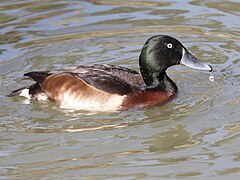Baer's Pochard
| Baer's Pochard | |
|---|---|
 | |
| Adult male (drake) | |
| Conservation status | |
| Scientific classification | |
| Kingdom: | Animalia |
| Phylum: | Chordata |
| Class: | Aves |
| Order: | Anseriformes |
| Family: | Anatidae |
| Subfamily: | Aythyinae |
| Genus: | Aythya |
| Species: | A. baeri |
| Binomial name | |
| Aythya baeri (Radde, 1863) | |
Baer's Pochard (Aythya baeri) is a diving duck found in eastern Asia. It breeds in southeast Russia and northeast China, migrating in winter to southern China, Vietnam, Japan, and India. The name commemorates the Estonian naturalist Karl Ernst von Baer.
At 41–46 cm, it is similar in size and stance to its close relative the Ferruginous Duck (A. nyroca), although the coloration of the drakes (males) is entirely different. Baer's Pochard males are similar to those of the Greater Scaup (A. marila), but have a dark back and upper flanks; the white lower flanks and belly are conspicuous. The females of Baer's Pochard and the Ferruginous Duck are quite similar, but that holds true for the females of almost all Aythya species. Eclipse males resemble females, but retain the white eye.
Formerly classified as a vulnerable species by the IUCN, recent research shows that its numbers are decreasing more and more rapidly. It was consequently uplisted to endangered status in 2008. Between 1987 and 2007, there were only eleven reports of groups of 100+ birds in mainland China. A recent census by WWF China of Hubei province found just 131 individuals on Liangzihu Lake, and only another three flocks of ten, eight, and three individuals at other sites. Hunting and wetland destruction are thought to be the causes of the decline; unconfirmed reports from eastern China suggest that as many as 3,000 individuals may be hunted every year.
Ecology
Baer's Pochard breeds around lakes with rich aquatic vegetation, nesting in dense grass, flooded tussock meadows, or flooded shrubby meadows. In Liaoning, China, it is normally found in densely vegetated coastal wetlands, or around lakes and ponds surrounded by forest. In winter, it occurs on freshwater lakes and reservoirs.

No comments:
Post a Comment